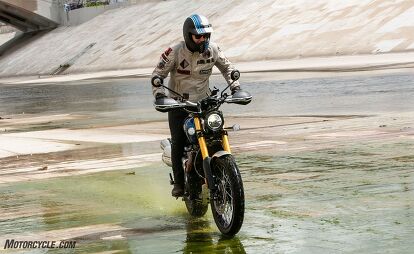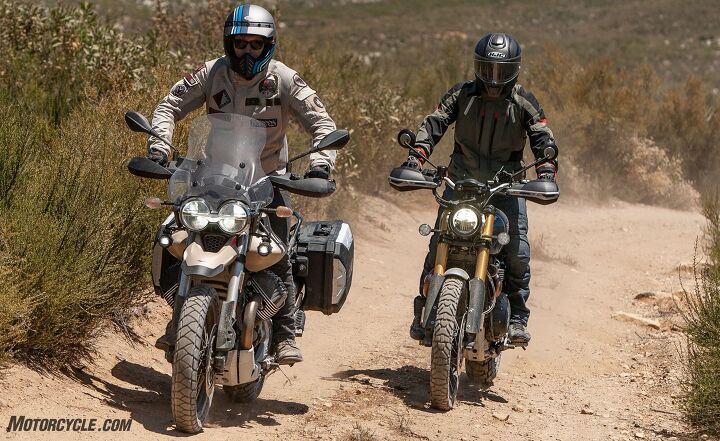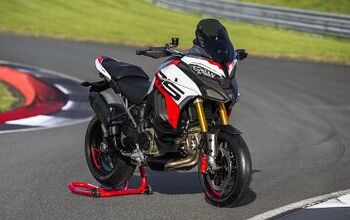Retro 80'Veez

Moto Guzzi V85 TT Travel & Triumph Scrambler 1200 XE
A head-to-head comparison this is not, but rather a showcase of two unique models that blur the lines of what adventure-capable motorcycles can look like. Triumph and Moto Guzzi, motorcycle manufacturers from two very different regions of Europe, both have long storied histories with plenty of ups and downs. The British brand dates back to 1902, two decades before Moto Guzzi began manufacturing in 1921.
2020 Moto Guzzi V85 TT Review – First Ride
2019 Triumph Scrambler 1200 XC And XE Review
It should come as no surprise, then, that these two manufacturers would be the brands to deliver to us a new take on the white-hot adventure segment while staying true to another popular genre, one that both companies excel at, modern retro motorcycles. Triumph’s latest Scrambler combines the brand’s modern classic styling with serious technology and off-road prowess. Moto Guzzi delivers a unique take on adventure touring with its V85 TT Travel, which shares styling reminiscent of the V65 TT raced in the ‘85 Paris-Dakar, though the machine boasts plenty of modern tech not before seen in the Guzzi lineup.
Aside from the aforementioned similarities, these two motorcycles go about their duties in totally different ways, making them entirely different steeds for different needs.
Triumph Scrambler 1200 XE
It’s been documented on these digital pages, in quotes shared in Triumph’s marketing, and even in other online publications, that I am, to put it lightly, a pretty big fan of the Triumph Scrambler 1200, particularly so in XE trim. Of course, we’re not talking Brasfield 790-obsessed levels, as there aren’t 20 articles on the site documenting it, but I dig it, for sure. It checks nearly all the right boxes for me. That’s not to say that after spending more time on the machine I haven’t noticed certain shortcomings, but none have been enough to put me off from the machine.
As mentioned to Rennie Scaysbrook in Cycle News: I love the mashup of technology and performance wrapped in nostalgic styling. The bike performs better off-road than some adventure bikes on the market, and it has classic style that will never go out of fashion. It is, quite literally, what scramblers were back in the day: streetbikes that could perform off-road.
I’ve toured England and Wales on-board the Scrambler 1200 XE. I’ve had the opportunity to rip around the Triumph Adventure Experience’s rented forest for a good bit of fun in the Welsh mud. I logged 2,500 miles on our press loaner. I’ve probably spent more time on this bike than any other motorcycle since I started this gig three years ago. The niggles I’ve noticed in that time do nothing to deter me from still considering the Scrambler 1200 XE as one of the few bikes I would consider spending my own money on.
The shortcomings amount to two things the Scrambler was never intended to do. Long-distance touring comfort wasn’t an issue around the UK where speeds are much lower, but elongated stints on America’s superslabs at 80 mph have the tendency to turn the rider into a sail with the motorcycle’s wide handlebar and lack of windscreen adding to the effect. I even found myself constantly having to hold my legs in toward the tank as the windblast would try to push them apart. It’s at about 75mph+ that this becomes a real annoyance.
Pull the Scrambler off its side stand, and you can feel every bit of its 508 pounds. It’s not that the Scrambler 1200 is so much heavier than other bikes on the market though. I had the Tiger 900 in the garage at the same time and weighed them back to back. The Tiger weighs in just five pounds less, yet pulling the bike off the side stand or pushing it around the driveway, it feels 50 pounds lighter and that’s due to its mass centralization and lower center of gravity. The Scrambler eschews this engineering concept in favor of keeping this bike in tune with the brand’s modern classic lineup. This feeling of top heaviness is only exacerbated in the dirt if the going gets slow and technical.
But hey, that’s life. The Scrambler 1200 XE already does a pretty good job of letting you have your cake and allowing you to huck it off jumps at moto-tracks, too.
Moto Guzzi V85 TT Travel
The Moto Guzzi V85 TT was another bike I was very excited about when I first saw prototypes from EICMA. It didn’t quite strike me the same way as the Triumph, but I appreciated the nod to its `80’s Dakar history (even if it was never fruitful) and the modernity that came packed into the model – which included technology borrowed from Piaggio’s higher tech brands like Aprilia.
Riding the V85 TT around Sardinia during the press launch was a special experience. Perfect winding roads with mostly pristine asphalt, distracting coastal views, and a group of competitive motorcycle journalists who are all eager to push a machine to its limits. We rode the peg feelers off of that set of V85s. Much harder than they’re likely to be flogged by the greater riding public, in the name of science, of course. I had little negative to say about the bike. Sure, it’s full of Guzzi “character”, and it’s not the fastest machine. Still, did it do what it was designed to do? With aplomb, as the motojournos say.
Finally having a go at the Guzzi V85 TT (Travel this time) stateside reveals mostly the same impressions from my first ride in Sardinia. The higher speed limits of the US tend to make the V85 TT feel slower still, but I really don’t mind… that much.
Navigating the menus can be frustrating off-road as you’ll have to go back a few layers deep into the menu to disable TC and ABS every time you turn off the key. There is an off-road mode which cuts ABS to the rear wheel and limits TC, but both are more intrusive than I prefer.
The experience of riding the Moto Guzzi V85 TT is such that the aforementioned negatives don’t outweigh the quirky fun character of the Italian machine.
TRIUMPH SCRAMBLER 1200 XE VS. MOTO GUZZI V85TT TRAVEL DEATHMATCH!!!
Although this isn’t a head-to-head comparison, we did ride them on the same terrain, on the same day, so we may as well tell you where the two excelled or came up short… in comparison.
The Triumph is the better off-road machine, and the Guzzi is the better tourer. Bam! There ya go. The End.
Okay, okay, we’ll give you more.
The two Twins are vastly different, with Moto Guzzi’s 853cc “transverse” V-Twin (all manufacturers except Guzzi would say longitudinal) coming up more than a few cubic centimeters short of the Triumph’s 1200cc parallel Twin. The V85’s mill is still one of the best parts of the machine, though, the sideways jolt when starting it, the mechanical, yet refined and well-timed low rpm loping on idle, and at full tilt, it sounds great. Troy dug it, maybe even moreso:
As the two of us said over and over during our time with the V85, it is such a cool bike to go slowly on – and I mean that in the best way possible. It’s comfortable and has hardly any vibrations, but what sweetens the deal is the sound it makes and the lopey, nonchalant power delivery. There are no surprises, everything feels very mechanical, and you’ll still get to your destination quicker than you would in a car. And you’ll feel much happier if you get there on the Guzzi than in any car.
The MG’s transmission behaves similarly to the engine. It can click off quick, clutchless upshifts if you want, but taking your time, clutching it in, then shifting gears somehow feels more pleasurable and correct.
Don’t get me wrong, the V85 will still move and pick up steam quicker than all but the craziest supercars out there, but its 853cc air-cooled, two-valve V-Twin only makes about 80 hp, says Moto Guzzi, so it’s best to readjust expectations if you’re coming to this bike from a competitor motorcycle with a bigger engine.
But as we’ve said too many times already, there’s no replacement for… blah blah, whatever. The Triumph’s engine is potent and not just for these kinds of bikes, it’s a real ripper, period. The claim is 90 hp at 7,400 rpm and 81 lb-ft of torque at a mere 3,950. It’s the torque that makes the motor so fun.
But you don’t have to take my word for it, let’s ask the sportbike guy: “First and foremost – what a cool engine! Tons of grunt, awesome sound (even with the stock pipe), and loads of character. Neither bike is lacking in cool points from the engine, but both engines are very different. Just like other Triumphs we’ve ridden lately, the Scrambler’s transmission is superb. Smooth, positive “clicks” for each upshift, and the downshifts are easy and clean, too.” – T. Siahaan.
I found the ride modes more useful on the Triumph simply because of the Off-road Pro riding mode, which disables TC and ABS, whereas, on the Guzzi, you need to select riding modes separately from disabling the party poopers.
The controls and general layout of the menus are more intuitive on the Triumph. I mean, the “M” button allows you to select modes on the Scrambler, while the “Mode” button on the Guzzi allows you to view Trip A and B as well as the menu screen, modes are changed with the starter button after the motorcycle is fired up, as one might expect.
“The V85 is a little on the heavy side, and with a name like TT Traveler, it’s safe to assume the bike is meant to tour. In that sense, the electronic aids like ABS and TC make sense, but unfortunately you can only either turn them on or off. There aren’t any stepped settings. This works fine most of the time, unless you’re wanting a bit more control (but not all of it) of the bike either on-road or off.” – Troy
The V85’s cockpit is the place to be for touring backroads or freeways. The riding position is nice and neutral, the seat is comfortable, and the large windscreen keeps the wind buffeting directly into your helmet – if you’re 5’8”. Both Troy and I are.
The Travel version of the V85 TT gets you key-matched side cases, auxiliary lighting, heated grips, Bluetooth connectivity and the previously mentioned windscreen (which is much larger than the one found on the other trims).
But, if getting off the beaten path is your thing, there aren’t that many bikes out there that do it better than the Scrambler 1200 XE. The Showa fork and Öhlins rear shocks provide 9.8 inches of clearance, and both are fully adjustable. That, combined with its sophisticated electronics (and the ability to disable them) and a torque monster of an engine combine to provide an incredibly fun machine in the dirt.
Troy: “With such a clear penchant for scrambling, the Triumph is relatively easy for a dirt noob like me to navigate and control.”
He says that now, but a few days ago…
The Moto Guzzi’s wheel sizes alone make it much less stable off-road, and quicker steering on-road compared to the Triumph. Not to mention the Guzzi’s suspension is much better set up for the odd cobblestone road rather than large rivulettes or small jumps. I’d say its stock tires aren’t the hot ticket for sand either.
“I noticed this before, but especially after Ryan mentioned it, the 19-inch front tire has a harder time rolling over rocks and ruts in the dirt compared to the Triumph’s 21-inch front,” says Troy. “On the road the 19-incher also contributed to the Guzzi’s slow steering, but it’s not like the Guzzi is in a rush to do anything, so the slow steering wasn’t bothering me.”
The nearly two-inch shorter seat height of the V85 TT Travel will appeal to a larger range of riders than the XE’s 34.3-inch saddle height. And while Troy felt different, I think the extremely narrow waist of the Guzzi also helped to easily flat-foot the bike, despite my 30-inch inseam. Both seats are equally as comfortable for the long hauls.
This was one of the most fun shoots I’ve had with the fellas for a while, and I can’t help to think it was, in part, to the motorcycles we were riding (and certainly not the lack of having to shoot video). They do a fantastic job at what they were designed to do and even manage to excel past their engineered duties in different ways.
Troy, the new Guzziphile, put it thusly: “This is one of those motorcycles that you can’t characterize from a spec sheet. On paper, the V85 is certainly nothing special, but it’s the sum of its parts – and the weird shimmying of its engine – that endears itself to the rider. It’s no wonder Guzzis have such a cult following.”
For me, I’ll deal with the windblast and high CoG on the Triumph for the off-road chops it has, but at the end of the day, I commend both manufacturers for being able to tap into the adventure segment in a unique way. Both bikes look great, have exceptional fit and finish and have garnered plenty of interest from passerbys.
Adventure is what you make of it. Go have one.
In Gear

Helmet: HJC RPHA 90 Tanisk $450-$455
- Jacket: Alpinestars Andes V2 Drystar Jacket $270
- Pants: Alpinestars Crank Riding Jeans $250
- Gloves: Alpinestars SP-2 v2 Gloves $220
Boots: Alpinestars Faster 3 Rideknit Shoes $180
In Gear

Helmet: Bell Moto-3 $300
- Jacket: Dainese Alger Nomads Jacket $580
- Gloves: Racer Mickey Gloves $220
Boots: REV’IT! Rodeo Boots $290
Specifications | 2020 Moto Guzzi V85 TT Travel | 2020 Triumph Scrambler 1200 XE |
|---|---|---|
| Engine Type | Air-cooled longitudinally-mounted 90° V-Twin, two valves per cylinder (titanium intake). | Liquid-cooled, 8-valve, SOHC, 270° crank angle parallel-twin |
| Displacement | 853cc | 1200 cc |
| Bore and stroke | 84 mm x 77 mm | 97.6 mm x 80.0 mm |
| Compression Ratio | 10.5:1 | 11.0:1 |
| Maximum Power | 80 hp at 7750 rpm (claimed) | 90 hp at 7400 rpm (claimed) |
| Torque | 59 lb-ft. at 5000 rpm (claimed) | 81.1 ft-lbs at 3950 rpm (claimed) |
| Fuel System | Electronic injection; Ø 52 mm single throttle body, Ride-by-Wire | Multipoint sequential electronic fuel injection |
| Final drive | Shaft | X ring chain |
| Clutch | Dry single disc | Wet, multi-plate assist clutch |
| Transmission | 6-speed | 6-speed |
| Frame | High strength steel tubular frame | Tubular steel with aluminum cradles |
| Front Suspension | 41 mm hydraulic telescopic USD fork, with adjustable spring preload and hydraulic rebound, 6.7 inches travel | Showa ⌀47mm fully adjustable USD forks. 9.8 inches wheel travel. |
| Rear Suspension | Double-sided swingarm in box-type aluminum with a single shock on the right side, with adjustable spring preload and hydraulic rebound, 6.7 inches travel | Öhlins fully adjustable piggy-back RSUs with twin springs. 9.8 inches wheel travel. |
| Front Brake | Double 320 mm stainless steel floating discs, Brembo radial-mounted calipers with 4 opposed pistons | Twin 320mm discs, Brembo M50 monoblock calipers, radial master cylinder. Switchable Cornering ABS |
| Rear Brake | Ø 260 mm stainless steel disc, floating caliper with 2 pistons | Single 255mm disc, Brembo 2-piston floating caliper. Switchable Cornering ABS |
| Front Wheel Rim | 2.50” x 19” | Tubeless 36-spoke 21 x 2.15in, aluminum rims |
| Rear Wheel Rim | 4.25” x 17” | Tubeless 32-spoke 17 x 4.25in, aluminum rims |
| Front Tire | With air chamber 110/80 R19 | 90/90-21 |
| Rear Tire | With air chamber 150/70 R17 | 150/70 R17 |
| Rake/Trail | 28°/5.04 inches | 26.9°/5.09 inches |
| Length | 88.2 inches | 91.5 inches |
| Width | 37.4 inches | 35.6 inches |
| Seat Height | 32.7 inches | 34.3 inches |
| Fuel Capacity | 5.5 gallons (including 1.3-gallon reserve) | 4.2 gallons |
| Dry weight | 459 pounds (claimed) | 456 pounds (claimed) |

Ryan’s time in the motorcycle industry has revolved around sales and marketing prior to landing a gig at Motorcycle.com. An avid motorcyclist, interested in all shapes, sizes, and colors of motorized two-wheeled vehicles, Ryan brings a young, passionate enthusiasm to the digital pages of MO.
More by Ryan Adams


















































































































































































Comments
Join the conversation
Both of these would be in my collection if I had the money and space. Got neither, C'est la vie...
I like both, but the Guzzi is the one I'd keep. Both look like a riot though.